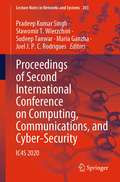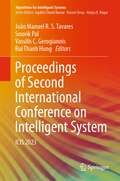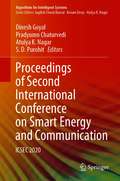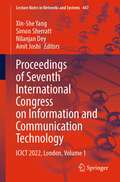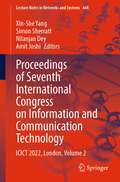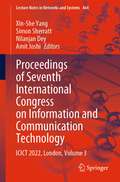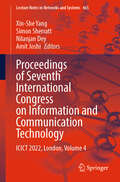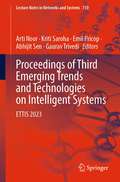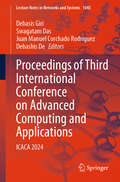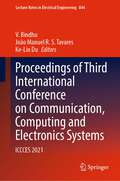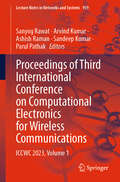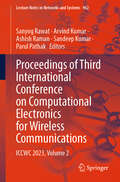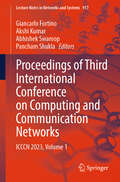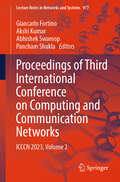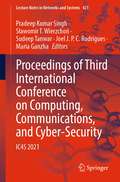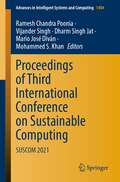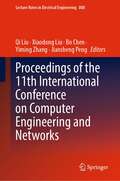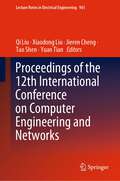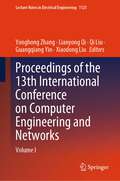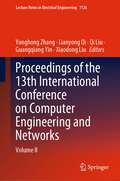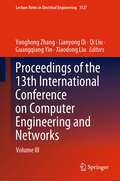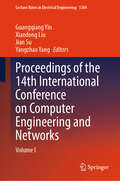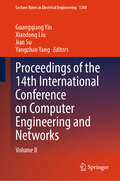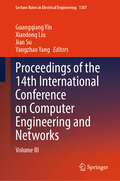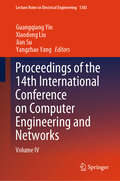- Table View
- List View
Proceedings of Second International Conference on Computing, Communications, and Cyber-Security: IC4S 2020 (Lecture Notes in Networks and Systems #203)
by Pradeep Kumar Singh Sudeep Tanwar Joel J. P. C. Rodrigues Maria Ganzha Sławomir T. WierzchońThis book features selected research papers presented at the Second International Conference on Computing, Communications, and Cyber-Security (IC4S 2020), organized in Krishna Engineering College (KEC), Ghaziabad, India, along with Academic Associates; Southern Federal University, Russia; IAC Educational, India; and ITS Mohan Nagar, Ghaziabad, India during 3–4 October 2020. It includes innovative work from researchers, leading innovators, and professionals in the area of communication and network technologies, advanced computing technologies, data analytics and intelligent learning, the latest electrical and electronics trends, and security and privacy issues.
Proceedings of Second International Conference on Intelligent System: ICIS 2023 (Algorithms for Intelligent Systems #21)
by João Manuel R. S. Tavares Souvik Pal Bui Thanh Hung Vassilis C. GerogiannisThis book gathers selected high-quality research papers presented at the Second International Conference on Intelligent System (ICIS 2023), organized by Industrial University of Ho Chi Minh City, Vietnam during September 29–30, 2023. It discusses high-quality and cutting-edge research in the areas of informatics, intelligent systems, and smart technologies and applications. The book is a collection of the latest research articles in intelligent control, artificial intelligence, neural networks, knowledge discovery, decision support systems, soft computing, data mining, and ontologies, machine learning, intelligent measurement, and other related fields.
Proceedings of Second International Conference on Smart Energy and Communication: ICSEC 2020 (Algorithms for Intelligent Systems)
by Atulya K. Nagar Dinesh Goyal Pradyumn Chaturvedi S. D. PurohitThis book gathers selected papers presented at the 2nd International Conference on Smart Energy and Communication (ICSEC 2020), held at Poornima Institute of Engineering and Technology, Jaipur, India, on March 20–21, 2020. It covers a range of topics in electronics and communication engineering and electrical engineering, including analog circuit design, image processing, wireless and microwave communication, optoelectronics and photonic devices, nano-electronics, renewable energy, smart grid, power systems and industry applications.
Proceedings of Seventh International Congress on Information and Communication Technology: ICICT 2022, London, Volume 1 (Lecture Notes in Networks and Systems #447)
by Xin-She Yang Nilanjan Dey Amit Joshi Simon SherrattThis book gathers selected high-quality research papers presented at the Seventh International Congress on Information and Communication Technology, held at Brunel University, London, on February 21–24, 2022. It discusses emerging topics pertaining to information and communication technology (ICT) for managerial applications, e-governance, e-agriculture, e-education and computing technologies, the Internet of Things (IoT) and e-mining. Written by respected experts and researchers working on ICT, the book offers a valuable asset for young researchers involved in advanced studies. The work is presented in four volumes.
Proceedings of Seventh International Congress on Information and Communication Technology: ICICT 2022, London, Volume 2 (Lecture Notes in Networks and Systems #448)
by Xin-She Yang Nilanjan Dey Amit Joshi Simon SherrattThis book gathers selected high-quality research papers presented at the Seventh International Congress on Information and Communication Technology, held at Brunel University, London, on February 21–24, 2022. It discusses emerging topics pertaining to information and communication technology (ICT) for managerial applications, e-governance, e-agriculture, e-education and computing technologies, the Internet of Things (IoT) and e-mining. Written by respected experts and researchers working on ICT, the book offers a valuable asset for young researchers involved in advanced studies. The work is presented in four volumes.
Proceedings of Seventh International Congress on Information and Communication Technology: ICICT 2022, London, Volume 3 (Lecture Notes in Networks and Systems #464)
by Xin-She Yang Nilanjan Dey Amit Joshi Simon SherrattThis book gathers selected high-quality research papers presented at the Seventh International Congress on Information and Communication Technology, held at Brunel University, London, on February 21–24, 2022. It discusses emerging topics pertaining to information and communication technology (ICT) for managerial applications, e-governance, e-agriculture, e-education and computing technologies, the Internet of Things (IoT) and e-mining. Written by respected experts and researchers working on ICT, the book offers a valuable asset for young researchers involved in advanced studies. The work is presented in four volumes.
Proceedings of Seventh International Congress on Information and Communication Technology: ICICT 2022, London, Volume 4 (Lecture Notes in Networks and Systems #465)
by Xin-She Yang Nilanjan Dey Amit Joshi Simon SherrattThis book gathers selected high-quality research papers presented at the Seventh International Congress on Information and Communication Technology, held at Brunel University, London, on February 21–24, 2022. It discusses emerging topics pertaining to information and communication technology (ICT) for managerial applications, e-governance, e-agriculture, e-education and computing technologies, the Internet of Things (IoT) and e-mining. Written by respected experts and researchers working on ICT, the book offers a valuable asset for young researchers involved in advanced studies. The work is presented in four volumes.
Proceedings of Third Emerging Trends and Technologies on Intelligent Systems: ETTIS 2023 (Lecture Notes in Networks and Systems #730)
by Emil Pricop Arti Noor Abhijit Sen Gaurav Trivedi Kriti SarohaThis book presents best selected papers presented at the International Conference on Emerging Trends and Technologies on Intelligent Systems (ETTIS 2023) held from 23 – 24 February 2023 in hybrid mode at C-DAC, Noida, India. The book includes current research works in the areas of artificial intelligence, big data, cyber-physical systems, and security in industrial/real-world settings. The book illustrates on-going research results, projects, surveying works, and industrial experiences that describe significant advances in all of the related areas.
Proceedings of Third International Conference on Advanced Computing and Applications: ICACA 2024 (Lecture Notes in Networks and Systems #1045)
by Debashis De Juan Manuel Corchado Rodríguez Swagatam Das Debasis GiriThis book gathers selected high-quality research papers presented at the 3rd International Conference on Advanced Computing and Applications (ICACA 2024), held virtually during 23–24 February 2024. The topics covered are advanced communication technologies, IoT-based systems and applications, network security and reliability, virtualization technologies, compressed sensors and multimedia applications, signal image and video processing, machine learning, pattern recognitions, intelligent computing, big data analytics, analytics in bio-computing, AI-driven 6G mobile wireless networks, and autonomous driving.
Proceedings of Third International Conference on Communication, Computing and Electronics Systems: ICCCES 2021 (Lecture Notes in Electrical Engineering #844)
by Ke-Lin Du João Manuel R. S. Tavares V. BindhuThis book includes high quality research papers presented at the International Conference on Communication, Computing and Electronics Systems 2021, held at the PPG Institute of Technology, Coimbatore, India, on 28-29 October 2021. The volume focuses mainly on the research trends in cloud computing, mobile computing, artificial intelligence and advanced electronics systems. The topics covered are automation, VLSI, embedded systems, optical communication, RF communication, microwave engineering, artificial intelligence, deep learning, pattern recognition, communication networks, Internet of Things, cyber-physical systems, and healthcare informatics.
Proceedings of Third International Conference on Computational Electronics for Wireless Communications: ICCWC 2023, Volume 1 (Lecture Notes in Networks and Systems #959)
by Sandeep Kumar Arvind Kumar Sanyog Rawat Ashish Raman Parul PathakThis book includes high-quality papers presented at the Third International Conference on Computational Electronics for Wireless Communications (ICCWC 2023), held at Dr. B. R. Ambedkar National Institute of Technology Jalandhar, India, during December 22-23, 2023. The book presents original research work of academics and industry professionals to exchange their knowledge of the state-of-the-art research and development in computational electronics with an emphasis on wireless communications. The topics covered in the book are radio frequency and microwave, signal processing, microelectronics, and wireless networks.
Proceedings of Third International Conference on Computational Electronics for Wireless Communications: ICCWC 2023, Volume 2 (Lecture Notes in Networks and Systems #962)
by Sandeep Kumar Arvind Kumar Sanyog Rawat Ashish Raman Parul PathakThis book includes high-quality papers presented at Third International Conference on Computational Electronics for Wireless Communications (ICCWC 2023), held at Dr. B. R. Ambedkar National Institute of Technology Jalandhar, India, during October 20–21, 2023. The book presents original research work of academics and industry professionals to exchange their knowledge of the state-of-the-art research and development in computational electronics with an emphasis on wireless communications. The topics covered in the book are radio frequency and microwave, signal processing, microelectronics, and wireless networks.
Proceedings of Third International Conference on Computing and Communication Networks: ICCCN 2023, Volume 1 (Lecture Notes in Networks and Systems #917)
by Giancarlo Fortino Akshi Kumar Abhishek Swaroop Pancham ShuklaThis book includes selected peer-reviewed papers presented at third International Conference on Computing and Communication Networks (ICCCN 2023), held at Manchester Metropolitan University, UK, during 17–18 November 2023. The book covers topics of network and computing technologies, artificial intelligence and machine learning, security and privacy, communication systems, cyber physical systems, data analytics, cyber security for industry 4.0, and smart and sustainable environmental systems.
Proceedings of Third International Conference on Computing and Communication Networks: ICCCN 2023, Volume 2 (Lecture Notes in Networks and Systems #977)
by Giancarlo Fortino Akshi Kumar Abhishek Swaroop Pancham ShuklaThis book includes selected peer-reviewed papers presented at third International Conference on Computing and Communication Networks (ICCCN 2023), held at Manchester Metropolitan University, UK, during 17–18 November 2023. The book covers topics of network and computing technologies, artificial intelligence and machine learning, security and privacy, communication systems, cyber-physical systems, data analytics, cybersecurity for Industry 4.0, and smart and sustainable environmental systems.
Proceedings of Third International Conference on Computing, Communications, and Cyber-Security: IC4S 2021 (Lecture Notes in Networks and Systems #421)
by Pradeep Kumar Singh Sudeep Tanwar Joel J. P. C. Rodrigues Maria Ganzha Sławomir T. WierzchońThis book features selected research papers presented at the Third International Conference on Computing, Communications, and Cyber-Security (IC4S 2021), organized in Krishna Engineering College (KEC), Ghaziabad, India, along with Academic Associates; Southern Federal University, Russia; IAC Educational, India; and ITS Mohan Nagar, Ghaziabad, India, during October 30–31, 2021. It includes innovative work from researchers, leading innovators, and professionals in the area of communication and network technologies, advanced computing technologies, data analytics and intelligent learning, the latest electrical and electronics trends, and security and privacy issues.
Proceedings of Third International Conference on Sustainable Computing: SUSCOM 2021 (Advances in Intelligent Systems and Computing #1404)
by Dharm Singh Jat Ramesh Chandra Poonia Mario José Diván Vijander Singh Mohammed S. KhanThe book includes a selection of the best papers presented at the Third International Conference on Sustainable Computing (SUSCOM 2021), held in Jaipur, India, during 19 – 20 March 2021. It covers topics like Internet of things (IoT); artificial system of security; smart storage and knowledge retrieval using data cloud; intelligent transport management; intelligent cognitive and bio-inspired computing and management science. The book is useful for peoples from academia, government bodies, healthcare and industry to discuss their future scope.
Proceedings of the 11th International Conference on Computer Engineering and Networks (Lecture Notes in Electrical Engineering #808)
by Bo Chen Yiming Zhang Qi Liu Xiaodong Liu Jiansheng PengThis conference proceeding is a collection of the papers accepted by the CENet2021 – the 11th International Conference on Computer Engineering and Networks held on October 21-25, 2021 in Hechi, China. The topics focus but are not limited to Internet of Things and Smart Systems, Artificial Intelligence and Applications, Communication System Detection, Analysis and Application, and Medical Engineering and Information Systems. Each part can be used as an excellent reference by industry practitioners, university faculties, research fellows and undergraduates as well as graduate students who need to build a knowledge base of the most current advances and state-of-practice in the topics covered by this conference proceedings. This will enable them to produce, maintain, and manage systems with high levels of trustworthiness and complexity.
Proceedings of the 12th International Conference on Computer Engineering and Networks (Lecture Notes in Electrical Engineering #961)
by Qi Liu Xiaodong Liu Yuan Tian Tao Shen Jieren ChengThis conference proceeding is a collection of the papers accepted by the CENet2022 – the 12th International Conference on Computer Engineering and Networks held on November 4-7, 2022 in Haikou, China. The topics focus but are not limited to Internet of Things and Smart Systems, Artificial Intelligence and Applications, Communication System Detection, Analysis and Application, and Medical Engineering and Information Systems. Each part can be used as an excellent reference by industry practitioners, university faculties, research fellows and undergraduates as well as graduate students who need to build a knowledge base of the most current advances and state-of-practice in the topics covered by this conference proceedings. This will enable them to produce, maintain, and manage systems with high levels of trustworthiness and complexity.
Proceedings of the 13th International Conference on Computer Engineering and Networks: Volume I (Lecture Notes in Electrical Engineering #1125)
by Qi Liu Xiaodong Liu Lianyong Qi Yonghong Zhang Guangqiang YinThis book aims to examine innovation in the fields of computer engineering and networking. The text covers important developments in areas such as artificial intelligence, machine learning, information analysis, communication system, computer modeling, internet of things. This book presents papers from the 13th International Conference on Computer Engineering and Networks (CENet2023) held in Wuxi, China on November 3-5, 2023.
Proceedings of the 13th International Conference on Computer Engineering and Networks: Volume II (Lecture Notes in Electrical Engineering #1126)
by Qi Liu Xiaodong Liu Lianyong Qi Yonghong Zhang Guangqiang YinThis book aims to examine innovation in the fields of computer engineering and networking. The text covers important developments in areas such as artificial intelligence, machine learning, information analysis, communication system, computer modeling, internet of things. This book presents papers from the 13th International Conference on Computer Engineering and Networks (CENet2023) held in Wuxi, China on November 3-5, 2023.
Proceedings of the 13th International Conference on Computer Engineering and Networks: Volume III (Lecture Notes in Electrical Engineering #1127)
by Qi Liu Xiaodong Liu Lianyong Qi Yonghong Zhang Guangqiang YinThis book aims to examine innovation in the fields of computer engineering and networking. The text covers important developments in areas such as artificial intelligence, machine learning, information analysis, communication system, computer modeling, internet of things. This book presents papers from the 13th International Conference on Computer Engineering and Networks (CENet2023) held in Wuxi, China on November 3-5, 2023.
Proceedings of the 14th International Conference on Computer Engineering and Networks: Volume I (Lecture Notes in Electrical Engineering #1384)
by Xiaodong Liu Jian Su Guangqiang Yin Yangzhao YangThis conference proceedings is a collection of papers accepted for CENet2024 - the 14th International Conference on Computer Engineering and Networks, held in Kashi, China, 18-21 October 2024. The topics covered include Internet of Things and Smart Systems, Artificial Intelligence and Applications, Detection, Analysis and Application of Communication Systems, Cloud Computing and Security, and Medical Engineering and Information Systems. Each section of this book can serve as an excellent reference for industry practitioners, university faculty, research fellows, undergraduate and graduate students who wish to build a knowledge base of the latest advances and state-of-the-art practices in the topics covered. Using this knowledge, they will be able to design, implement and manage systems that are both complex and trustworthy. We would like to thank the authors for their hard work and dedication, and the reviewers for their efforts in ensuring that only the highest quality papers were selected. Without their contributions, the proceedings would not have been possible.
Proceedings of the 14th International Conference on Computer Engineering and Networks: Volume II (Lecture Notes in Electrical Engineering #1388)
by Xiaodong Liu Jian Su Guangqiang Yin Yangzhao YangThis conference proceedings is a collection of papers accepted for CENet2024 - the 14th International Conference on Computer Engineering and Networks, held in Kashi, China, 18-21 October 2024. The topics covered include Internet of Things and Smart Systems, Artificial Intelligence and Applications, Detection, Analysis and Application of Communication Systems, Cloud Computing and Security, and Medical Engineering and Information Systems. Each section of this book can serve as an excellent reference for industry practitioners, university faculty, research fellows, undergraduate and graduate students who wish to build a knowledge base of the latest advances and state-of-the-art practices in the topics covered. Using this knowledge, they will be able to design, implement and manage systems that are both complex and trustworthy. We would like to thank the authors for their hard work and dedication, and the reviewers for their efforts in ensuring that only the highest quality papers were selected. Without their contributions, the proceedings would not have been possible.
Proceedings of the 14th International Conference on Computer Engineering and Networks: Volume III (Lecture Notes in Electrical Engineering #1387)
by Xiaodong Liu Jian Su Guangqiang Yin Yangzhao YangThis conference proceedings is a collection of papers accepted for CENet2024 - the 14th International Conference on Computer Engineering and Networks, held in Kashi, China, 18-21 October 2024. The topics covered include Internet of Things and Smart Systems, Artificial Intelligence and Applications, Detection, Analysis and Application of Communication Systems, Cloud Computing and Security, and Medical Engineering and Information Systems. Each section of this book can serve as an excellent reference for industry practitioners, university faculty, research fellows, undergraduate and graduate students who wish to build a knowledge base of the latest advances and state-of-the-art practices in the topics covered. Using this knowledge, they will be able to design, implement and manage systems that are both complex and trustworthy. We would like to thank the authors for their hard work and dedication, and the reviewers for their efforts in ensuring that only the highest quality papers were selected. Without their contributions, the proceedings would not have been possible.
Proceedings of the 14th International Conference on Computer Engineering and Networks: Volume IV (Lecture Notes in Electrical Engineering #1383)
by Xiaodong Liu Jian Su Guangqiang Yin Yangzhao YangThis conference proceedings is a collection of papers accepted for CENet2024 - the 14th International Conference on Computer Engineering and Networks, held in Kashi, China, 18-21 October 2024. The topics covered include Internet of Things and Smart Systems, Artificial Intelligence and Applications, Detection, Analysis and Application of Communication Systems, Cloud Computing and Security, and Medical Engineering and Information Systems. Each section of this book can serve as an excellent reference for industry practitioners, university faculty, research fellows, undergraduate and graduate students who wish to build a knowledge base of the latest advances and state-of-the-art practices in the topics covered. Using this knowledge, they will be able to design, implement and manage systems that are both complex and trustworthy. We would like to thank the authors for their hard work and dedication, and the reviewers for their efforts in ensuring that only the highest quality papers were selected. Without their contributions, the proceedings would not have been possible.
